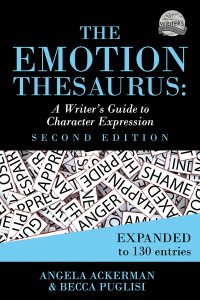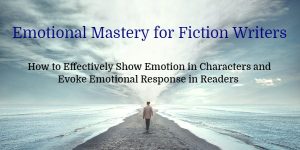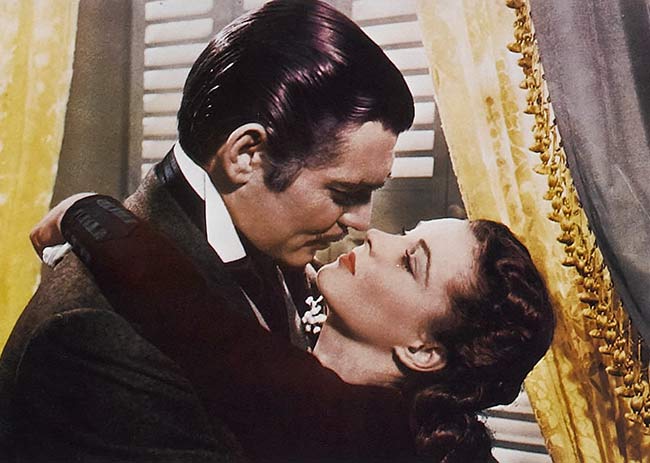The Connection between Character Emotion and Reader Empathy
Today’s guest post is by Becca Puglisi.
Do you know how many books are on the market today? Neither do I; I can’t count that high. I do know that in 2015 alone, over a million books were published.
This is awesome for readers, but it creates a problem for authors looking to create a fan base. Not only do we need customers to find our books, we need them to love them—enough to finish them and go on to consume everything else we have to offer.
To make it in this crowded space, we need to attract readers who are obsessed with our work. We want them staying up late and oversleeping because they couldn’t put our book down, texting friends to tell them how awesome it is, and running to the computer when they’re done to see if there are more coming out.
Basically, we want raving fans—customers who read all of our stuff and do the word-of-mouth marketing for us. But how do we get this kind of response to our books?
We do it by generating empathy.
When readers start to care about the main character, they’re going to be invested in what happens to him. And they’re going to keep reading to make sure everything turns out okay.
This means we have to get readers feeling as they read. And the best way to do that is by conveying the character’s emotion in a way that evokes emotion in the reader. Let me give you an example from the (newly released) second edition of The Emotion Thesaurus:
Jason tapped on the door frame. The battle-axe didn’t look up, just kept slashing through numbers on her sales report.
“Um, Mrs. Swanson?” No response. He shifted his weight, wondering how to proceed. He couldn’t mess this up. He couldn’t miss another of Kristina’s games.
Jason shuffled half a step into her office. “Um … about this weekend? I know your email said I needed to work, but … Well, I kind of already have plans—”
“Cancel them,” she said in a tone that was as forgiving as her Sharpie. When he didn’t answer, she looked up.
His gaze dropped to the rug.
In this example, it’s easy to see what the character is feeling without it having to be stated. The body language cues (the tentative tap on the door, his shuffling steps) combined with his speech hesitations and unsettled thoughts convey uncertainty and nervousness. This is an example of emotion that has been shown rather than told, and it works for building character empathy for a few reasons.
It Makes the Reader an Active Participant
Showing emotion is effective because it pulls the reader in close to what’s happening. When readers are simply told what the character’s feeling (Jason was nervous), they’re not involved; they’re put at a distance, just sitting back and listening to someone tell them what’s going on.
But when the character’s emotions are shown through body language, vocal cues, thoughts, and dialogue, readers are able to infer what’s happening for themselves.
This process of figuring things out is part of what makes reading such a satisfying experience. We don’t want everything explained to us; it’s rewarding to be able to follow the clues and put the pieces together, even if we don’t know that’s what we’re doing. Showing emotion gives readers that opportunity.
It Engages the Reader’s Emotions
 Emotions are universal—meaning, whatever your character is feeling, the reader has most likely felt it too. When we’re able to show that emotion in an evocative way, it can evoke a hint of that same feeling for the reader, because they’ve experienced what the character is going through.
Emotions are universal—meaning, whatever your character is feeling, the reader has most likely felt it too. When we’re able to show that emotion in an evocative way, it can evoke a hint of that same feeling for the reader, because they’ve experienced what the character is going through.
Readers who feel a sense of doubt or fear or elation are going to be far more engaged than ones who sit back and watch other people feeling those emotions.
Showing Emotion Creates a Sense of Shared Experience
When readers recognize the character’s emotional state as one they’ve experienced in the past, it creates a sense of shared experience. Readers will connect with the character, even on a subconscious level, because of this thing they have in common. This is a common way for empathy to begin.
When we master the art of showing emotion, readers become active participants in the story, their emotions are engaged, and they feel a sense of kinship with the character. All of this can lead to increased empathy and the reader being invested enough in the character to keep reading. If we can accomplish this in all of our books, it just might result in customers who keep coming back for more.
 Becca Puglisis is an international speaker, writing coach, and bestselling author of books for writers—including her latest publication: a second edition of The Emotion Thesaurus, an updated and expanded version of the original volume. Her books are available in multiple languages, are sourced by US universities, and are used by novelists, screenwriters, editors, and psychologists around the world. She is passionate about learning and sharing her knowledge with others through her Writers Helping Writers blog and via One Stop For Writers—a powerhouse online library created to help writers elevate their storytelling.
Becca Puglisis is an international speaker, writing coach, and bestselling author of books for writers—including her latest publication: a second edition of The Emotion Thesaurus, an updated and expanded version of the original volume. Her books are available in multiple languages, are sourced by US universities, and are used by novelists, screenwriters, editors, and psychologists around the world. She is passionate about learning and sharing her knowledge with others through her Writers Helping Writers blog and via One Stop For Writers—a powerhouse online library created to help writers elevate their storytelling.
Want to master the emotional craft of fiction?
Dive into the online course Emotional Mastery for Fiction Writers!
In this course, you’ll be given tools to show emotions in your characters. You’ll be given techniques to help spark emotional response in your readers. What is going to bring it all together for you is practice. Study and practice. And you’ll have exercises in this course to help you put into practice what you learn.
There are two facets of emotion in fiction: conveying what your character is feeling and evoking emotion in your reader. We’ll look at these two facets separately and in de pth. Yet, they are intrinsically connected.
pth. Yet, they are intrinsically connected.
Emotional mastery requires writers to set up the dynamics of a scene in such a visual, textural way that readers can’t help but feel what they are meant to feel. Understanding that emotional mastery requires a twofold approach—the emotional landscape of both the character and the reader—is the first step.
Want to learn how to become a masterful wielder of emotion in your fiction? Enroll in my new online video course, Emotional Mastery for Fiction Writers.
You’ll get lifetime access to all the videos and more than three dozen downloadable assignments. And with a 30-day money-back guarantee, you have NOTHING to lose by jumping in. Sign up NOW.
This course will challenge you to become an “emotion master.” Are you ready and willing to go on this journey deep into emotional territory? If you want your characters to move your readers, take the plunge!












Thanks so much for having Becca by today, Susanne! We sure appreciate you letting us nerd out over a topic we both love. 🙂
Angela
Always a pleasure!
Great post, Becca! This helps me remember that actions speak better than words in story. All best to you!